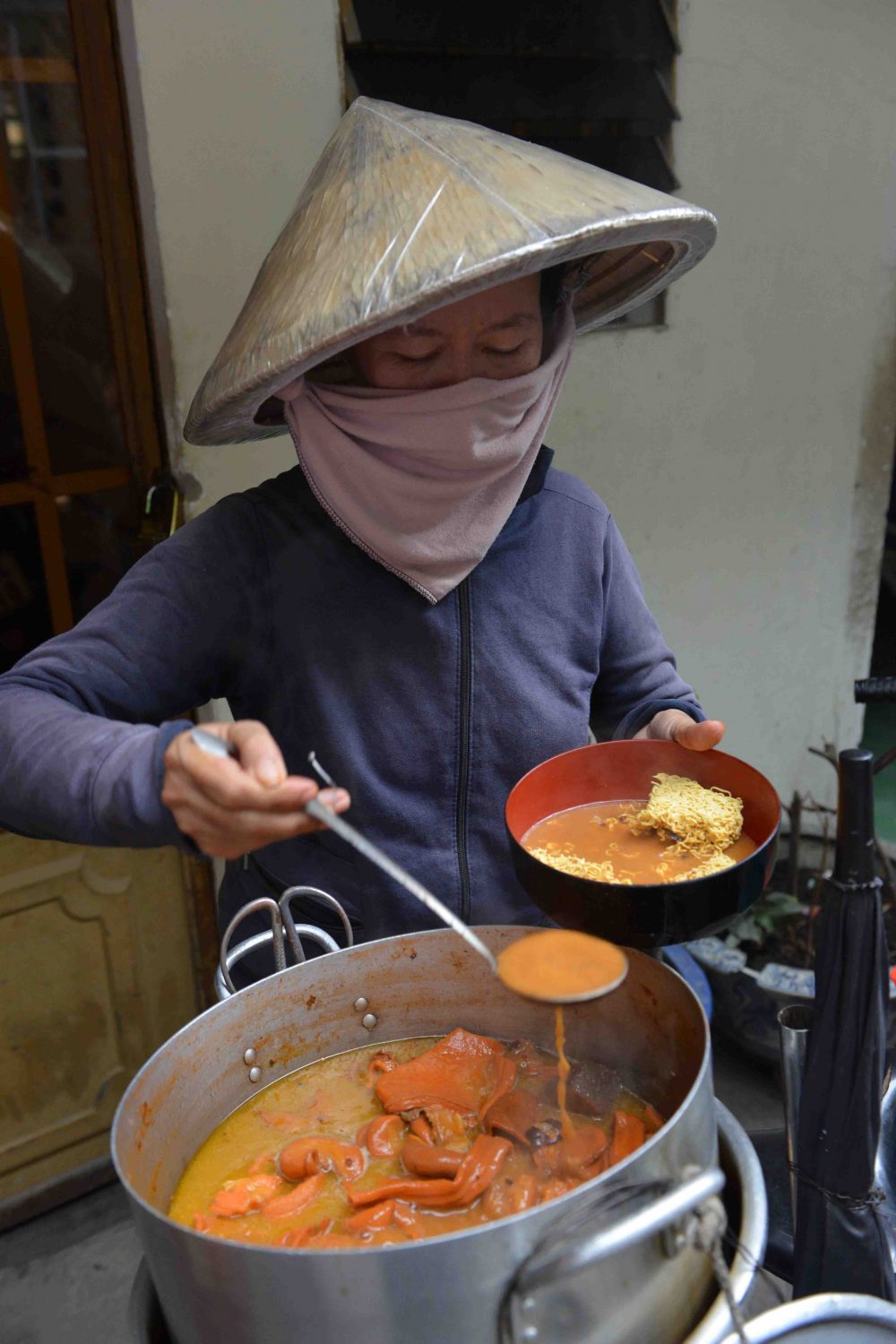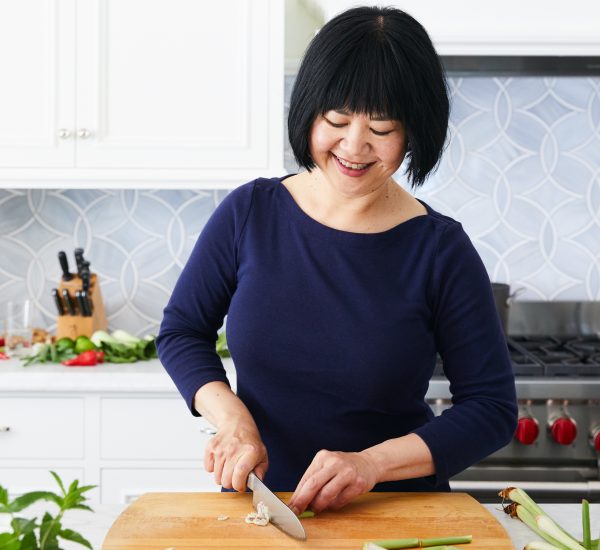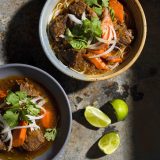
You smell them before you see them, the winding and narrow stone alleys of Quận 8—or District 8—a cluster of narrow strips of land set off by a series of canals at the heart of Ho Chi Minh City. The air is heavy with ginger, garlic, fish sauce and lemon grass, the wildly aromatic mother ingredients for so much of Vietnamese cooking.
Step into the welcoming, if disorienting, warren and the source of the savory breeze is obvious. In Quận 8, the cooking occurs in the alleys, in the open doorways of the small homes that spill onto them. Propane burners and squat tables—some fixed, others happenstance—fill a narrow space outside most, families crowded around.
Neighbors chatter as rice noodles mound and pots of stock simmer in anticipation of lunch under the shade of awnings that crisscross overhead. And for those who’d rather not prepare their own? A surprising option pedals past me, stopping in an only slightly broader section of the alley—a woman with a simmering cauldron of soup perched on her rear tire.
The kettle—which steams with many gallons of richly red broth—sits inside a second, larger pot that holds the coals that keep her offerings hot. The dish is phá lấu bò, a stew of beef organs, cinnamon, coconut milk, garlic and vinegar. As customers approach, she hops off the bicycle to fill deep bowls first with noodles, then ladles of stew. The cost—about 65 cents.
What is so alluring about bò kho—and Vietnamese cooking in general—is how every ingredient earns its keep by amplifying flavor. Nothing here is subtle.
I didn’t know it at the time, but phá lấu bò is a relative of a stew I would learn later that afternoon. Nguyên Thį Thúy, a literature teacher who invited me into her kitchen, had offered to teach me bò kho, an equally fragrant, equally brothy beef stew flavored with star anise, lemon grass, garlic, ginger and—rather than offal—beef brisket.
What is so alluring about the recipe—and Vietnamese cooking in general—is that every step, every ingredient, must earn its keep in the recipe. And it earns it by amplifying flavor. Nothing here is subtle. Not the 5-inch chunk of ginger that will season the dish. Not the massive cleaver with which Nguyên expertly dispatches the mound of beef.
The pot fills quickly as Nguyên’s husband tends to plants in the courtyard that blurs the line between living room and kitchen, children and grandchildren variably helping and getting underfoot. There is sugar, salt and shallots. There is chili-garlic paste and curry paste, a potent blend of cardamom, coriander, cinnamon and turmeric, among others.
Some recipes call for coconut milk, but Nguyên—who laughs when saying that when she got married, she didn’t know how to cook, but has since taught herself through much trial and error—favors lighter, fresher coconut water for the backbone of her broth. More ginger and now lemon grass, smashed and minced. It is less about exacting cooking and more about knowingly combining high-flavor ingredients and letting them do the work for her.
Star anise and sweet carrots round it out, and then the stew simmers, filling the home with those same alluring aromas that earlier had led me through Quận 8—ginger, cinnamon, garlic, citrusy lemon grass. Mostly untended, the stew cooks for a few hours. When I join the family to taste the results, we ladle it over bowls of tender rice noodles.
It’s almost ridiculously flavorful and beefy. Rich without heft, the cinnamon and star anise pleasantly strong and warm. The shallots and carrots sweeten, balancing the ginger and garlic. The only thing I’m left wondering... How does one balance a cauldron of this on the back of a bicycle?

Story by Andrea Nguyen
In Vietnam, coconut water (nước dừa) harvested from young, green coconuts is both a thirst quencher and culinary weapon for times when you want a soft, sweet lilt, as in Nguyên Thį Thúy’s rendition of bò kho beef stew. Viet cooks favor the slightly opaque refresher for preparing savory-sweet southern classics that feature pork or seafood, bittersweet caramel sauce and fish sauce. Small amounts of naturally occurring sugars and sodium give coconut water a mild salinity and sweetness. And those sugars undergo the Maillard reaction when heated, which deepens the flavors and color.
Some folks also use it for nước chấm, the ubiquitous spicy-sweet dipping sauce. In my California kitchen, I adore it for making a vibrant turmeric and coconut rice, in which the water lends the grains a tropical note without weighing them down the way coconut milk often can.
Unless you want to go old school and buy a fresh coconut to hack at, head to the supermarket juice section. Back in the 1970s, my family resorted to sweetened coconut juice or soda because that was all we could get in the U.S. With coconut water within easy reach now, everyone can replicate the flavors of Vietnam.
Related Recipes
January-February 2021

Sign up to receive texts
Successfully signed up to receive texts!
We'll only send our very best offers - Like a $15 store credit to start.
By entering your phone number and submitting this form, you consent to receive marketing text messages (such as promotion codes and cart reminders) from Christopher Kimball's Milk Street at the number provided, including messages sent by autodialer. Consent is not a condition of any purchase. Message and data rates may apply. Message frequency varies. You can unsubscribe at any time by replying STOP or clicking the unsubscribe link (where available) in one of our messages. View our Privacy Policy and Terms of Service.






